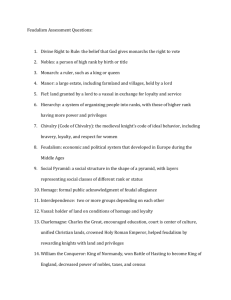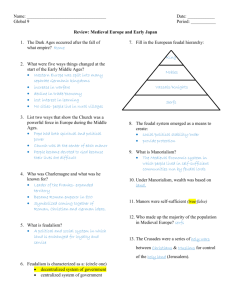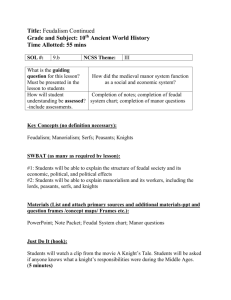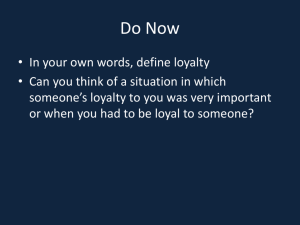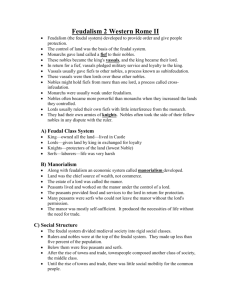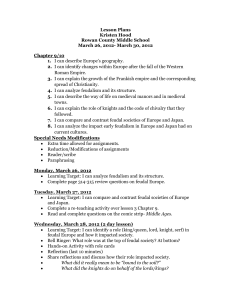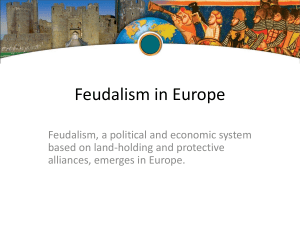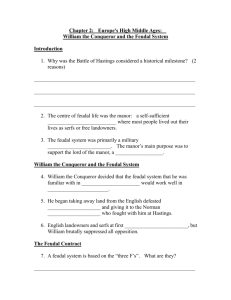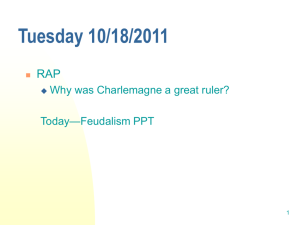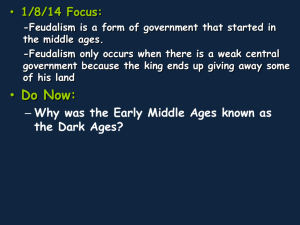Student`s Name
advertisement
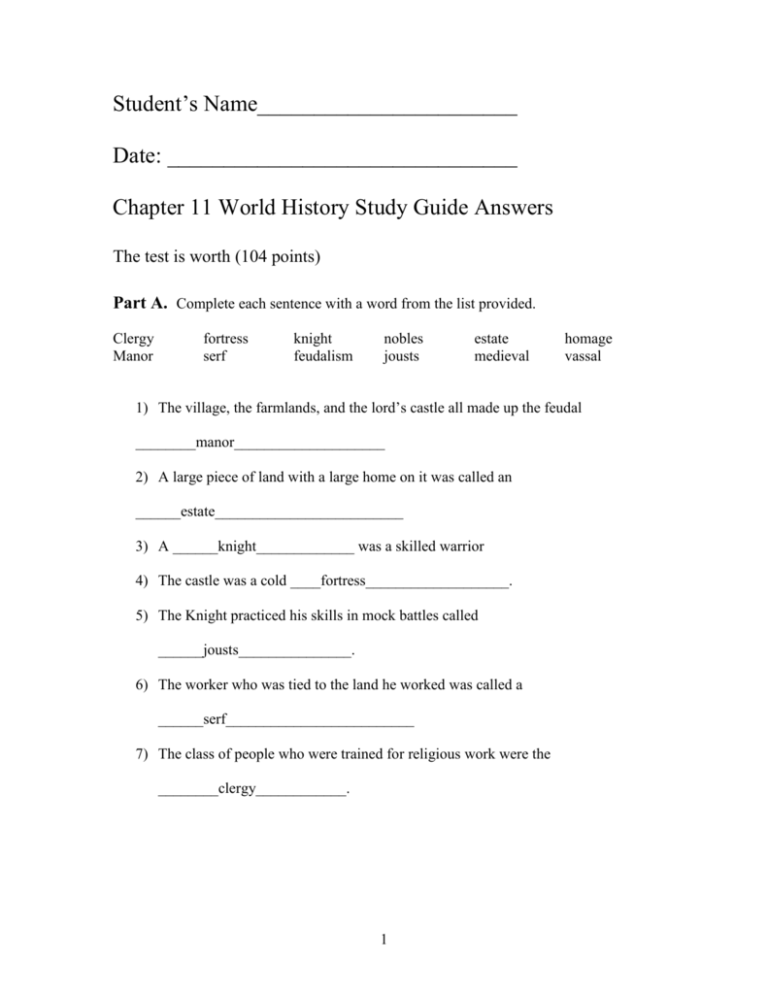
Student’s Name_______________________ Date: _______________________________ Chapter 11 World History Study Guide Answers The test is worth (104 points) Part A. Complete each sentence with a word from the list provided. Clergy Manor fortress serf knight feudalism nobles jousts estate medieval homage vassal 1) The village, the farmlands, and the lord’s castle all made up the feudal ________manor____________________ 2) A large piece of land with a large home on it was called an ______estate_________________________ 3) A ______knight_____________ was a skilled warrior 4) The castle was a cold ____fortress___________________. 5) The Knight practiced his skills in mock battles called ______jousts_______________. 6) The worker who was tied to the land he worked was called a ______serf_________________________ 7) The class of people who were trained for religious work were the ________clergy____________. 1 8) The economic system of exchanging land for services was called ______feudalism_______________________ 9) The act of providing troops, reverence and obedience to a superior was called an act of __homage_________________________________ 10) In western Europe, feudalism was the primary political and economic system during the ______medieval __________ period of history. 11) A noble who received land from the king was called a ___vassal____________. 12) The class of society who paid homage to the king in exchange for land were the _____nobles____________________. Part B. Read each statement. If it is true, write T. If it is false, write F. 13) ______T_______ The serf was almost a slave during the Middle Ages. 14) _________T_______ Religion played an important part in medieval life. 15) ________F________ There were many laws to make certain that the lords treated the serfs fairly. 16) ________T________ Many of the nobles were also knights. 17) _____T________ When people began to move back to the cities and towns, the feudal system died out. 18) ________F________ The plague that killed 1/4th to 1/3rd of Europe’s people was called the “Red Death”. 19) _______F_________ A knight was tasked to do religious work for the nobles. 20) _________F_______ All people were treated equally under the feudal system. 21) _______F_________ No one but people of the manor were allowed at manor fairs. 22) ______F__________Jousts were quiet serious events. 23) _________F_______ Monks and nuns were outlawed during the middle ages. 2 24) _______T_________ Feudalism was primarily a defensive strategy designed to protect the kingdom from outside invasion. 25) ________F________ Under the feudal system, great achievements were made in medicine and science. 26) _______T_________ Medieval castles were usually cold and often dark and gloomy. 27) _______T_________ Nobles had to promise to fight for their lord. 28) ______T__________ Serfs did not own the land they worked upon. 29) ______F__________ Trade grew quickly under the feudal system. 30) ______F__________ In medieval times, all of the clergy were poor. 31) ______F__________ Only serfs could become knights. 32) _______F_________ Serfs owned their own land. 33) _______T_________ Serfs and nobles alike went to medieval fairs. 34) ________F________ Serfs and nobles alike went to jousting tournaments. 35) _______T_________ The lord of the manor was the absolute ruler of the feudal estate. 36) ______F__________ The clergy wasn’t important under the feudal system. 37) ______T__________ One would likely find jugglers at fairs and at jousts. 38) ______T__________ Under feudalism the vassal noblemen were obligated to provide military troops whenever called upon by their lords. 39) ______T__________ When gunpowder, cannons and foot soldiers came into use, knights were no longer needed. 40) ______T__________ From the film on the Vikings shown during class. The reason given for the invasion of France and England was the need for money by the chiefs in their quests to unify Scandinavia. 41) ______F_________ The deep draft of the dragon boats made them very effective raiders because they could cross both oceans and travel in rivers. 3 42) ______T__________ Peat was the primary source of iron that the Vikings used for making iron weapons. 43) ___F____________ Knights were warriors from the lowest class of feudal society. Part C. The following questions come from the reading on the Black Death and Magic Cures 44) The Black death was probably caused by a. Rotten food b. Cold weather c. Infected rat fleas 45) Abracadabra was a. A magic charm b. A famous doctor c. A city in Italy 46) The doctor’s best advice to avoid the plague was to a. Get plenty of rest b. Not drink the water c. Run away 47) People turned to magic because a. Doctors could not cure them. b. Doctors were too expensive c. Both a and b 48) When the Black death had run its course, the number of people who had died was a. More than 50 million. b. About 25 million c. Less than 10 million 4 Part D. Choose one of the best answers to each item. 49) Under the system of feudalism a. Serfs were tied to the land b. Land was exchanged for services c. Nobles promised to serve the king d. All of the above 50) A fortress was a. A building with strong walls for defense against an enemy b. c. d. e. A way to settle disagreements between countries A tournament to help knights practice their fighting skills A sevret method of gaining a wife. None of the above 51) A knight was needed because a. Estates fought each other b. Robbers roamed the land. c. Outside tribes were looking for new lands d. All of the above 52) The Black Death spread throughout Europe because a. Villages were dirty and there was little medical knowledge b. All the rats had died c. The kings and nobles refused medical treatment d. The feudal way of life was ending. 5

